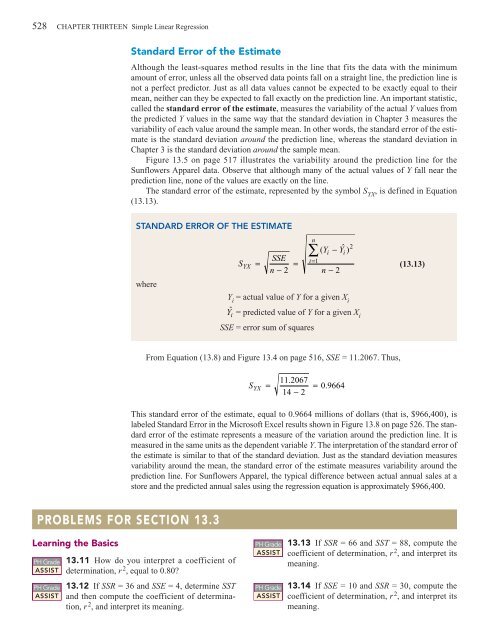CHAPTER 13 Simple Linear Regression
CHAPTER 13 Simple Linear Regression
CHAPTER 13 Simple Linear Regression
You also want an ePaper? Increase the reach of your titles
YUMPU automatically turns print PDFs into web optimized ePapers that Google loves.
528 <strong>CHAPTER</strong> THIRTEEN <strong>Simple</strong> <strong>Linear</strong> <strong>Regression</strong><br />
Standard Error of the Estimate<br />
Although the least-squares method results in the line that fits the data with the minimum<br />
amount of error, unless all the observed data points fall on a straight line, the prediction line is<br />
not a perfect predictor. Just as all data values cannot be expected to be exactly equal to their<br />
mean, neither can they be expected to fall exactly on the prediction line. An important statistic,<br />
called the standard error of the estimate, measures the variability of the actual Y values from<br />
the predicted Y values in the same way that the standard deviation in Chapter 3 measures the<br />
variability of each value around the sample mean. In other words, the standard error of the estimate<br />
is the standard deviation around the prediction line, whereas the standard deviation in<br />
Chapter 3 is the standard deviation around the sample mean.<br />
Figure <strong>13</strong>.5 on page 517 illustrates the variability around the prediction line for the<br />
Sunflowers Apparel data. Observe that although many of the actual values of Y fall near the<br />
prediction line, none of the values are exactly on the line.<br />
The standard error of the estimate, represented by the symbol S YX<br />
, is defined in Equation<br />
(<strong>13</strong>.<strong>13</strong>).<br />
STANDARD ERROR OF THE ESTIMATE<br />
S<br />
YX<br />
=<br />
( Yi<br />
− Yˆ i)<br />
SSE i=<br />
1<br />
=<br />
n − 2 n − 2<br />
n<br />
∑<br />
2<br />
(<strong>13</strong>.<strong>13</strong>)<br />
where<br />
Y i<br />
= actual value of Y for a given X i<br />
ˆ Y i<br />
= predicted value of Y for a given X i<br />
SSE = error sum of squares<br />
From Equation (<strong>13</strong>.8) and Figure <strong>13</strong>.4 on page 516, SSE = 11.2067. Thus,<br />
S YX =<br />
11.<br />
2067<br />
14 − 2<br />
= 0.<br />
9664<br />
This standard error of the estimate, equal to 0.9664 millions of dollars (that is, $966,400), is<br />
labeled Standard Error in the Microsoft Excel results shown in Figure <strong>13</strong>.8 on page 526. The standard<br />
error of the estimate represents a measure of the variation around the prediction line. It is<br />
measured in the same units as the dependent variable Y. The interpretation of the standard error of<br />
the estimate is similar to that of the standard deviation. Just as the standard deviation measures<br />
variability around the mean, the standard error of the estimate measures variability around the<br />
prediction line. For Sunflowers Apparel, the typical difference between actual annual sales at a<br />
store and the predicted annual sales using the regression equation is approximately $966,400.<br />
PROBLEMS FOR SECTION <strong>13</strong>.3<br />
Learning the Basics<br />
PH Grade<br />
ASSIST<br />
PH Grade<br />
ASSIST<br />
<strong>13</strong>.11 How do you interpret a coefficient of<br />
determination, r 2 , equal to 0.80?<br />
<strong>13</strong>.12 If SSR = 36 and SSE = 4, determine SST<br />
and then compute the coefficient of determination,<br />
r 2 , and interpret its meaning.<br />
PH Grade<br />
ASSIST<br />
PH Grade<br />
ASSIST<br />
<strong>13</strong>.<strong>13</strong> If SSR = 66 and SST = 88, compute the<br />
coefficient of determination, r 2 , and interpret its<br />
meaning.<br />
<strong>13</strong>.14 If SSE = 10 and SSR = 30, compute the<br />
coefficient of determination, r 2 , and interpret its<br />
meaning.

















